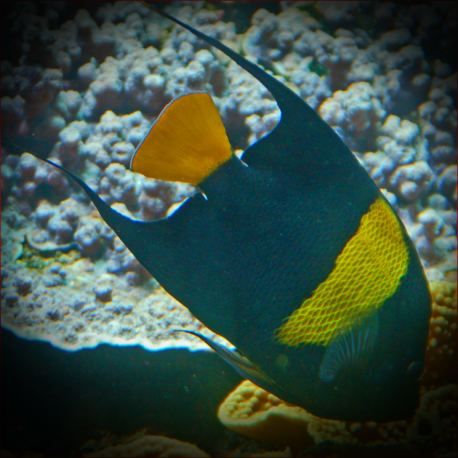More info
Datasheet
| Minimum Tank Size | 800 litres / 211.34 US gallons |
| Maximum Size | 40.0cm / 15.75inches |
| Reef Compatible | Not reef safe |
| Temperament | Might be aggressive towards other species |
| Temperature | 22.2°C / 71.96°F - 25.6°C / 78.08°F |
| Specific Gravity | 1.020-1.025 |
| Carbonate Hardness | 8-12 |
| pH | 8.1-8.4 |
General Description
The Asfur Angelfish, scientifically known as Pomacanthus asfur, belongs to the Pomacanthidae family and is a stunning species known for its vibrant colors and intricate patterns. These angelfish typically feed on sponges, soft corals, tunicates, and macroalgae in their natural habitat. There is a noticeable distinction in appearance between juveniles and adults, with adults growing rapidly, especially when well-fed. In captivity, they may take some time to adjust to aquarium conditions and feeding habits, preferring small and frequent feedings throughout the day.
Aquarium Suitability
Considered suitable for aquariums, the Asfur Angelfish demand a high water quality, including proper oxygenation. They require an established tank of at least 800 liters for optimal care. These fish can be aggressive, particularly towards timid tank mates, and should be introduced last in a community aquarium. They are not compatible with species like Lionfish, Seahorses, and Scorpionfish due to potential predatory behavior and should be fed a varied diet rich in algae-based foods for their well-being.
Care and Hardiness
With an average hardiness level, Asfur Angelfish acclimate best to aquarium conditions when introduced at a young age. They may initially be shy and refuse to eat, but with patience, they can adapt and accept a diverse diet. Providing ample space for swimming and hiding spots, along with maintaining high salinity levels, is crucial for their overall well-being. These fish thrive in well-established tanks with plenty of algae for grazing and should be fed multiple times a day, especially upon introduction to a new environment.
Reef Suitability
Categorized as not reef-safe, Asfur Angelfish are known to nibble on clams, including Tridacna species, and may exhibit aggressive behavior towards corals and other invertebrates in a reef setting. While they can coexist with carefully selected corals like Hammer corals and Bubble corals if provided with appropriate hiding places, caution is advised when choosing tank mates for a reef aquarium.
Aquarium Setup
For an optimal aquarium setup for Asfur Angelfish, a tank of at least 800 liters with a stable salinity level of 1.026 sg or higher is recommended. Incorporating live rocks and ample hiding spots is essential, along with maintaining a varied diet that includes algae-rich foods like nori seaweed and spirulina. It is advisable to avoid introducing aggressive tank mates initially and to create a well-maintained environment that supports their grazing habits.
Behaviour
Asfur Angelfish can display aggressive behavior, especially towards more timid tank mates, and may vocalize grunting sounds when threatened. They thrive in environments with plenty of space for swimming and grazing on algae-rich surfaces. Additionally, these fish are hermaphroditic, with the ability to change gender from female to male as needed for reproduction purposes.
Feeding and Diet
Their recommended diet includes larger crustaceans, macroalgae, microalgae, other invertebrates, small crustaceans, and sponges. Asfur Angelfish require frequent feedings multiple times a day to ensure they receive adequate nutrition, especially during their initial acclimation period. Supplementing their diet with algae-rich foods is essential to meet their dietary requirements.
Dimorphism
Asfur Angelfish exhibit distinct differences between juveniles and adults, with adults typically displaying more vibrant colors and intricate patterns. In captivity, successful captive reproduction may be achievable with proper care and a suitable tank setup that mimics their natural habitat.
Habitat and Distribution
Found in the Western Indian Ocean, particularly in the Red Sea and the Gulf of Aden, the Asfur Angelfish inhabits waters extending south to Zanzibar. Their natural habitat consists of reefs with an abundance of sponges, soft corals, tunicates, and macroalgae, where they forage for food and seek shelter among live rocks and crevices.

